




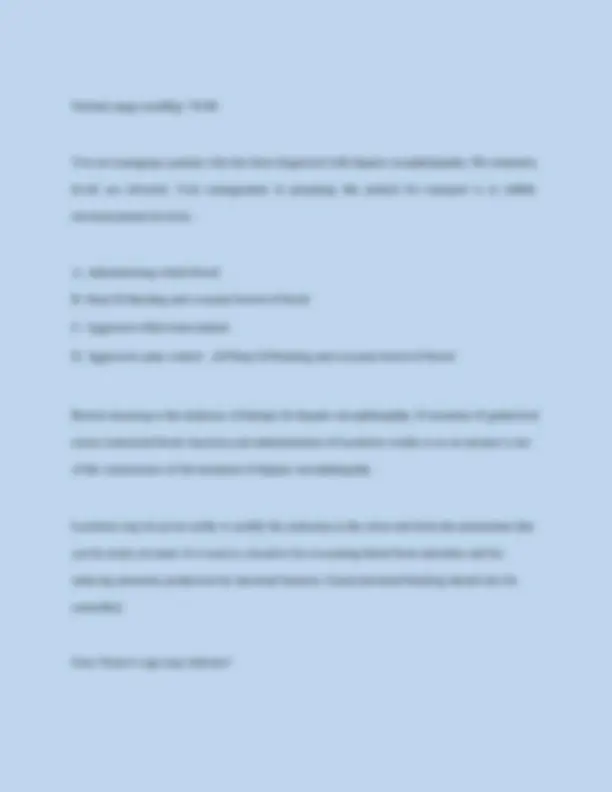
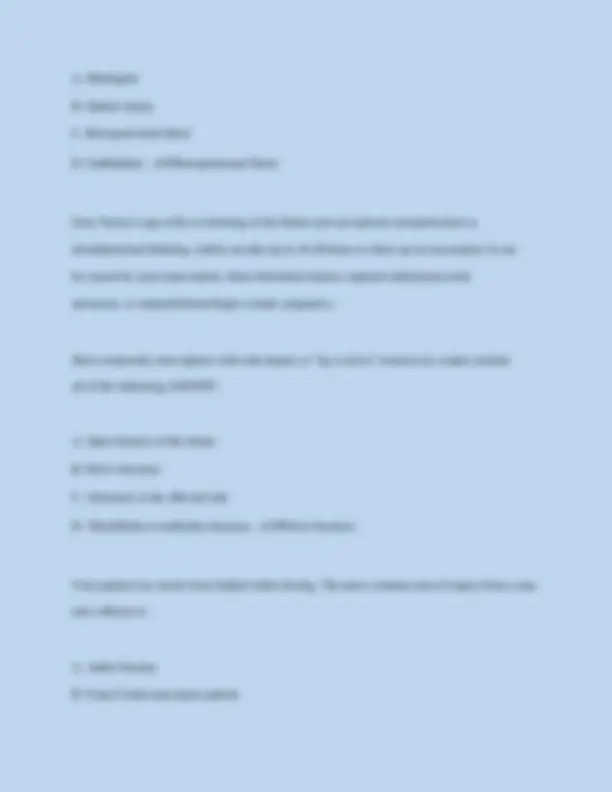





















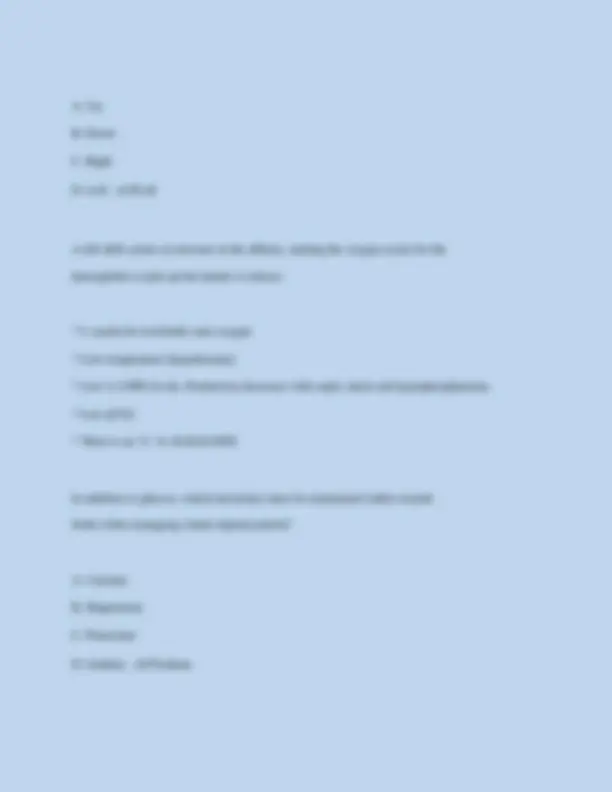







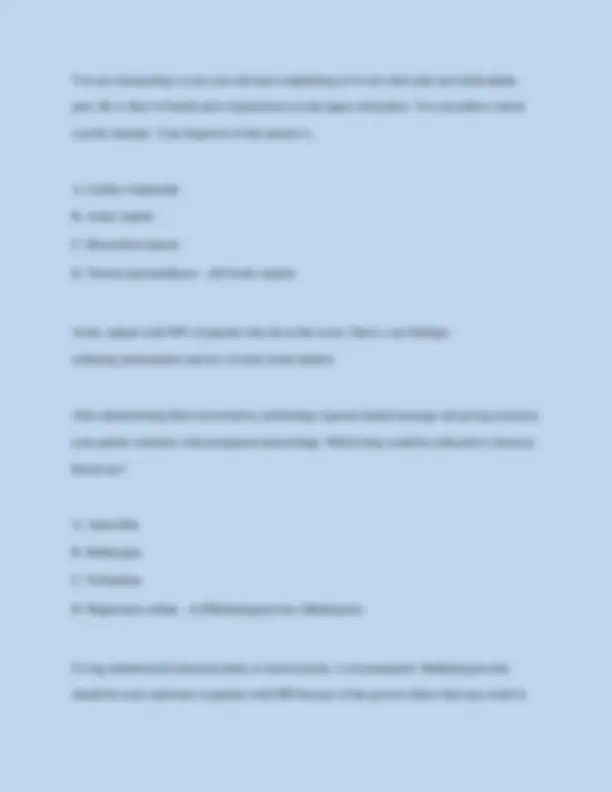

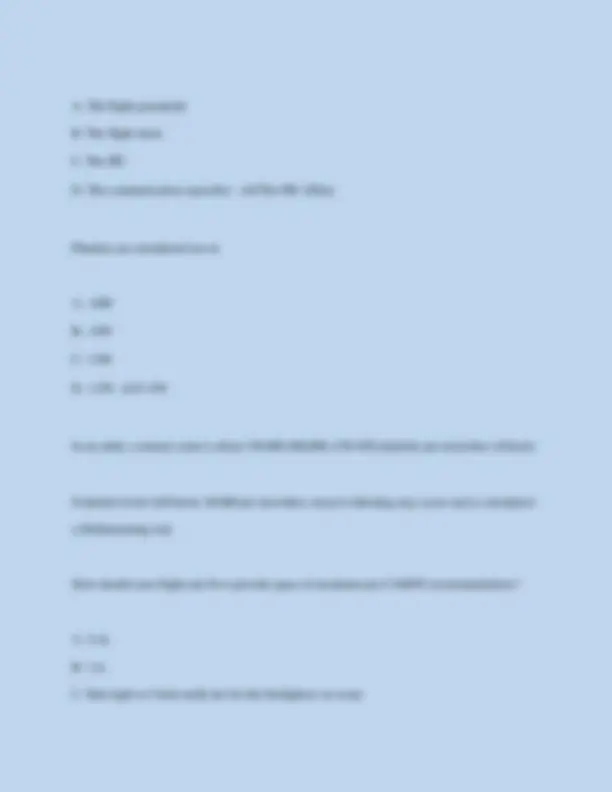















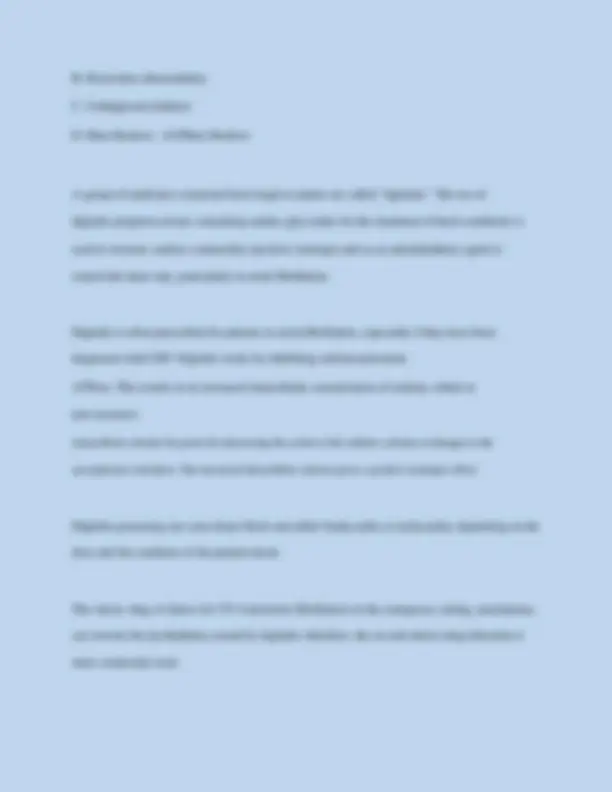
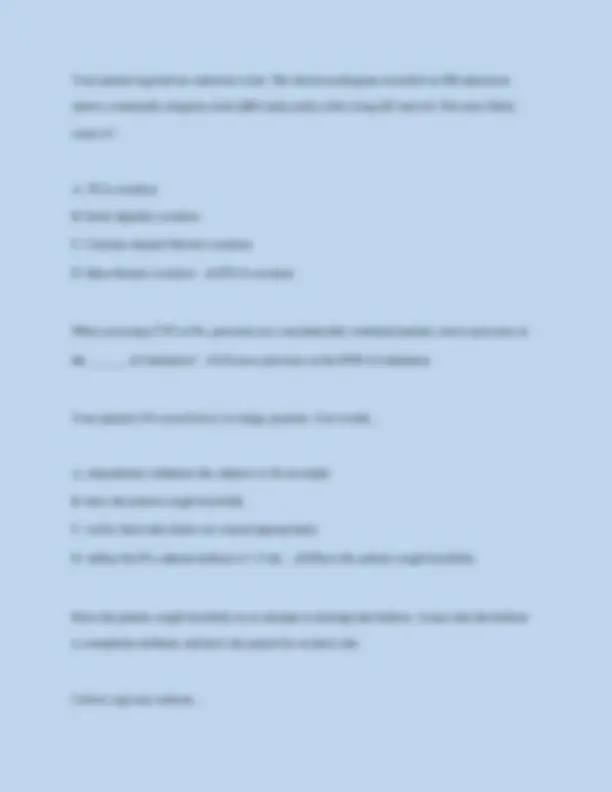
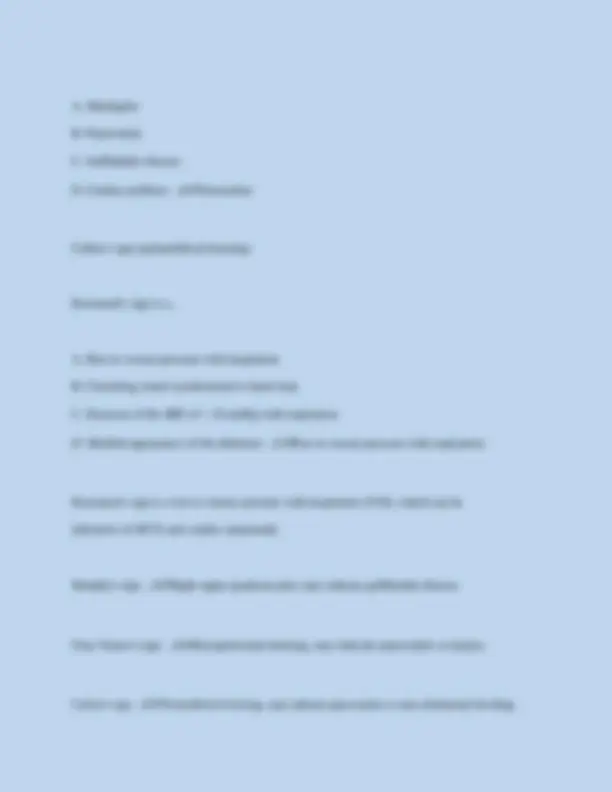



Study with the several resources on Docsity

Earn points by helping other students or get them with a premium plan


Prepare for your exams
Study with the several resources on Docsity

Earn points to download
Earn points by helping other students or get them with a premium plan
Community
Ask the community for help and clear up your study doubts
Discover the best universities in your country according to Docsity users
Free resources
Download our free guides on studying techniques, anxiety management strategies, and thesis advice from Docsity tutors
FPC / CFRN - Review Exam - Version B with 100% Correct Answers | Verified | Updated 2025 Myxedema coma is also known as... A. Thyroid storm B. Adrenal insufficiency C. Hypothyroidism D. Hyperaldosteronism - ✔✔Hypothyroidism Most common presentation of a patient with hypothyroidism are all of the following, Except... A. Cold intolerance with coarse hair B. Almost exclusively over the age of sixty C. >90% of cases occur in the winter D. Primarily in men - ✔✔Primarily in men
Typology: Exams
1 / 65

This page cannot be seen from the preview
Don't miss anything!


























































Myxedema coma is also known as... A. Thyroid storm B. Adrenal insufficiency C. Hypothyroidism D. Hyperaldosteronism - ✔✔Hypothyroidism Most common presentation of a patient with hypothyroidism are all of the following, Except... A. Cold intolerance with coarse hair B. Almost exclusively over the age of sixty C. >90% of cases occur in the winter D. Primarily in men - ✔✔Primarily in men Hypothroidism occurs primarily in women, almost exclusively over the age of sixty, with 90% of the cases occurring in the winter months. Your patient presents with following parameters: CVP 0, CI 1, PA S/D 8/4, wedge 3, and SVR 1,800. What is your diagnosis?
A. Hypovolemic shock
A. 0-10 mmHg B. 10-20 mmHg C. 20-30 mmHg D. >30 mmHg - ✔✔Normal ICP range is 0-10 mmHg, but range can go as high as 15 mmHg. The formula to calculate MAP is A. 2/3 DBP × SBP B. 2 × DBP + SBP divided by 3 C.2×SBP+DBP D. 2 + DBP × SBP divided by 3 - ✔✔2 × DBP + SBP / 3 (normal 80- 100 mmHg) Normal coronary perfusion pressure (CPP) is A. 50-60 mmHg B. 70-90 mmHg C. 80-100 mmHg D. <50 mmHg - ✔✔Normal 50-60 mmHg Coronary perfusion pressure: (CPP) = DBP-PAWP
The patient presents with the following hemodynamic parameters: CVP 1, CI 1.7, PA S/D 12/6, wedge 6, and SVR 300. Vital signs are 78/40, HR 60, RR 16, SaO2 98%. The most likely cause is... A. RVMI B. Neurogenic shock C. Septic shock D. Hypovolemic shock - ✔✔Neurogenic shock SVR < 800, think distributive shock. Next look at the CI; is it less than 2.5? Hypotension and either a normal heart and/or bradycardia present narrows the type of distributive shock as being neurogenic shock. Severe hypothermic Pt's are at highest risk for which of the following rhythm? A. A-Fib B. Asystole C. V-Fib D. Sinus Brady - ✔✔V-Fib Severe: 20-28 (coma, VF common) The drug of choice for a patient exhibiting signs and symptoms of malignant hyperthermia is:
Drug choice for cyclic antidepressant OD - ✔✔Sodium bicarbonate Drug choice for beta-blocker OD - ✔✔Glucagon Fentanyl dose - ✔✔Sublimaze (3 μg/kg) Treatment for malignant hyperthermia - ✔✔Dantrium (dantrolene) Drug for GI bleeds - ✔✔Sandostatin (octreotide) You have been requested to transport a twenty-year-old female from an ICU with a history of TCA overdose two hours prior to your arrival at the sending facility. Your cardiovascular assessment of the patient would most likely include all of the following with this type of toxicity, EXCEPT... A. Early sinus bradycardia B. Widening QRS C. Prolonged QT and PR interval D. Early tachycardia - ✔✔Early sinus bradycardia Sinus tachycardia is the most common cardiac disturbance seen following TCA overdose.
Rhabdomyolysis treatment - ✔✔- preventing shock and preserving kidney fxn - NS with sodium bicarbonate Your patient presents with ABG's of pH 7.39, pCO2 68 HCO3 32, pO2 82. He has history of COPD and weighs 65 kg. He presents with a history of SOB for 3 days with a RR 20 and is on 4 L/minute of oxygen by NC. He speaks in four- to five-word sentences. What acid-base disorder is present? A. Metabolic acidosis with partial compensation B. Respiratory acidosis with complete compensation C. Metabolic alkalosis with no compensation D. Respiratory alkalosis with no compensation - ✔✔Respiratory acidosis with complete compensation. The pCO2 is elevated, which is the primary disorder, and the compensatory response is the increased HCO3. The pH is normal, so there is complete compensation. Which formula can be used when calculating a cerebral perfusion pressure (CPP)? A. [(DBP × 2) + SBP] divided by 3 B. MAP − ICP C. ICP − DBP D. [(DBP + 2) × SBP] divided by 3 - ✔✔MAP − ICP = CPP
A. Meningitis B. Splenic injury C. Retroperitoneal bleed D. Gallbladder - ✔✔Retroperitoneal bleed Grey Turner's sign refers to bruising of the flanks and can indicate retroperitoneal or intraabdominal bleeding, which can take up to 24-48 hours to show up on assessment. It can be caused by acute pancreatitis, blunt abdominal trauma, ruptured abdominal aortic aneurysm, or ruptured/hemorrhagic ectopic pregnancy. Most commonly seen injuries with side impact or "lay it down" motorcycle crashes include all of the following, EXCEPT: A. Open fracture of the femur B. Pelvic fractures C. Abrasions to the affected side D. Tibia/fibula or malleolus fractures - ✔✔Pelvic fractures Your patient was struck from behind while driving. The most common area of injury from a rear- end collision is: A. Ankle fracture B. Coup Contrecoup injury pattern
C. C2 fracture D. T12-L1 injuries - ✔✔T12-L1 injuries Dry chemicals such as lime should be... A. Brushed off before irrigation B. Neutralized with a special agent before irrigation C. Irrigated immediately with water or physiologic saline D. Wrapped in a dressing and not irrigated - ✔✔Brushed off before irrigation Chemical burns differ from thermal burns in that the burning process continues until the agent is inactivated by reaction of tissues: neutralized or diluted with water. Dry chemicals, such as lime, should be brushed off before irrigation. Water and physiologic saline are fluids of choice for wound irrigation. Hamman's sign may indicate which of the following? A. Tension pneumothorax B. Tracheobronchial injury C. Aortic rupture D. Cardiac tamponade - ✔✔Tracheobronchial injury
The management approach for a patient experiencing brain herniation can include all of the following, EXCEPT: A. Serum sodium goal 155 B. Serum osmolality less than 320 C. Hypertonic saline, mannitol D. Hyperventilation to maintain EtCO2 at 20-30 mmHg - ✔✔Hyperventilation to maintain EtCO2 at 20-30 mmHg Routine hyperventilation is not longer recommended in the initial management of the patient with traumatic brain injury. The patient's EtCO2 should be maintained between 35-45 mmHg. Classic picture of neurogenic shock presents with... A. Hypertension B. Absence of tachycardia C. Cool skin D. Pallor - ✔✔Absence of tachycardia Loss of sympathetic tone below the level of the injury results in loss of autoregulation, a decrease in vascular tone, and inability of the heart to increase its intrinisic rate. The classic picture of neurogenic shock presents with the absence of tachycardia.
You are transporting a patient with a spinal cord injury above T6 level. His baseline vital signs prior to lift off: BP 160/80, HR 62, RR 20. During transport, the patient begins to complain of a throbbing headache with nasal stuffiness. Your assessment reveals that the patient is becoming increasingly agitated. His skin color is flushed and profusely diaphoretic. Repeat vital signs are a BP 206/100, HR 52, RR 26. Your initial management of the patient would be... A. Insert a foley catheter B. Administer nitroglycerin to help reduce blood pressure C. Hang a Nipride drip if diastolic is greater than 130 mmHg D. Do nothing because increased HTN is expected with altitude and spinal cord injuries. - ✔✔Insert a foley catheter Autonomic dysreflexia (AD), also known as "autonomic hyperreflexia or hyperreflexia," is a potentially life-threatening condition, which can be considered a medical emergency requiring immediate attention. AD occurs most often in spinal cord-injured individuals with spinal lesions above the T6 spinal cord level. Acute AD is a reaction of the autonomic (involuntary) nervous system to overstimulation.
It is characterized by disproportionately greater motor impairment in upper compared to lower extremities and variable degree of sensory loss below the level of injury. Most often occurs after hyperextension injury. - ✔✔"Central cord" syndrome Sinusoidal patterns are commonly associated with all of the following, EXCEPT: A. Fetal hypovolemia or anemia B. Accidental tap of the umbilical cord during amniocentesis C. Pregnancy-induced hypertension (PIH) D. Placental abruption - ✔✔Pregnancy-induced hypertension A uniform sine wave pattern indicates fetal hypovolemia or anemia and may occur in cases of erythroblastosis fetalis, accidental tap of the umbilical cord during amniocentesis, fetomaternal transfusion, placental abruption, or another type of accident. Diving injuries - 1 ATM for every ??? feet descent - ✔✔1 ATM for every 33 feet descent You will be transporting a stable twenty-seven-year-old man with nontraumatic pneumocephalous secondary to gas producing necrotizing bacteria from rural hospital at 8, feet elevation to a local hospital at 1,200 feet sea level. What might be the best transport option? What gas law will most affect this patient negatively? A. Ground; Boyle's law
B. Fixed wing transport pressurized to 9,000 AGL; Charles' law C. Rotor transport; Boyle's law D. Rotor transport; Charles' law - ✔✔Ground; Boyle's law Pneumocephalus is the presence of air or gas within the cranial cavity. It is usually associated with disruption of the skull: after head and facial trauma, tumors of the skull base, after neurosurgery or otorhinolaryngology, and rarely, spontaneously. Pneumocephalus can occur in scuba diving, but is very rare in this context. Unpressurized aircraft is not recommended for this patient's condition. When performing a pericardiocentesis, the insertion site is... A. Below the subxyphoid process B. Just right of the subxyphoid process C. Just left of the subxyphoid process D. Above the subxyphoid process - ✔✔Just left of the subxyphoid process The initial treatment of a patient with a suspected cardiac tamponade is a rapid intravenous fluid bolus. Pericardial blood will generally NOT CLOT because it has been defibrinated by heart motion.
You are transporting a seventy-five-year-old man with a diagnosis of inferior wall MI. During the flight you note V-Tach. Vital signs are: 70/palp, HR 150, RR 24, SpO2 94% on high flow oxygen with NRM at 15 L/min. He is awake and complains of chest pain and SOB. How will you manage this patient? A. Administer lidocaine and nitroglycerin B. Administer normal saline bolus C. Consider sedation and synchronize cardiovert at 100 joules D. Have the patient cough forcefully - ✔✔Consider sedation and synchronize cardiovert at 100 joules. The patient you are transporting reveals the following ABG: pH 7.51, pCO2 28, HCO3 24, pO
Minute ventilation is... A. RR × weight in kg B. RR × SPO C. Vt × weight in kg D. Vt × RR - ✔✔Vt × RR Tidal volume times the respiratory rate equal minute ventilation. Minute ventilation is defined as the total volume of air (gas) moved into and out of the lungs each minute. The formula is known as VE = Vt × f. VE signifies minute ventilation; Vt signifies tidal volume and f signifies respiratory rate. Alveolar minute volume is the amount of gas that reaches the alveoli for gas exchange in one minute. The formula is VAmin = (VT-VD) × Respiratory Rate. High-pressure alarms can be caused by all of the following, EXCEPT: A. Hypovolemia B. Connections C. Pneumothorax D. Obstructions - ✔✔Hypovolemia Low-pressure alarms can be caused by all of the following, EXCEPT: